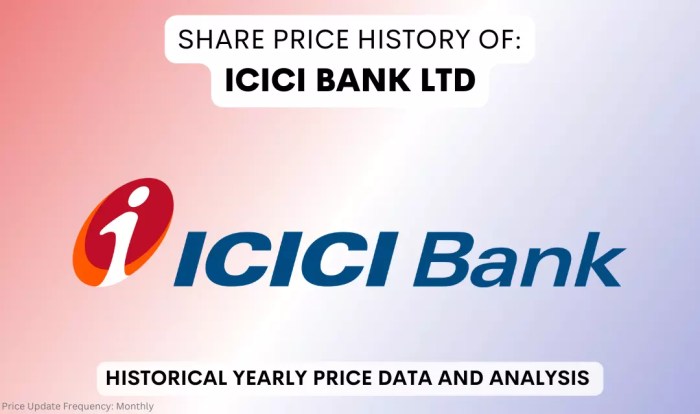ICICI Bank’s Current Market Position in India
Icici stock price india – ICICI Bank holds a significant position within India’s competitive banking landscape. This section details its current market standing, comparing its performance with key rivals and analyzing factors influencing its stock price.
ICICI Bank’s Market Standing and Competitive Analysis
A detailed analysis of ICICI Bank’s current market position requires considering its market capitalization and market share alongside a comparison with its main competitors. While precise, real-time data fluctuates constantly, we can illustrate a typical comparison.
| Bank Name | Market Cap (Illustrative) | Year-over-Year Growth (Illustrative) | Key Strengths |
|---|---|---|---|
| ICICI Bank | ₹X trillion (Illustrative) | Y% (Illustrative) | Strong retail banking presence, robust digital platforms, diversified loan portfolio. |
| SBI | ₹Z trillion (Illustrative) | A% (Illustrative) | Largest public sector bank, extensive branch network, government backing. |
| HDFC Bank | ₹W trillion (Illustrative) | B% (Illustrative) | Strong private sector bank, focus on retail and corporate banking, high profitability. |
Note: Market capitalization and growth figures are illustrative and subject to change. Actual figures should be verified from reliable financial sources.
Factors Influencing ICICI Bank’s Stock Price
Several factors contribute to the fluctuations in ICICI Bank’s stock price. These include macroeconomic conditions (interest rates, inflation, GDP growth), the bank’s financial performance (profitability, asset quality, capital adequacy), investor sentiment, and regulatory changes.
- Financial Performance: Strong earnings, robust loan growth, and efficient cost management positively impact the stock price.
- Macroeconomic Environment: Economic growth generally benefits banks, while high inflation and rising interest rates can create challenges.
- Regulatory Changes: New banking regulations or policy shifts can affect profitability and investor confidence.
- Investor Sentiment: Positive news and analyst upgrades typically boost the stock price, while negative news can lead to sell-offs.
Historical Stock Price Performance and Trends
Analyzing ICICI Bank’s historical stock price performance provides valuable insights into its long-term growth potential and the impact of various factors on its valuation.
Five-Year Stock Price Performance
A line graph depicting ICICI Bank’s stock price over the past five years would show fluctuations influenced by economic cycles, company performance, and external events. For example, periods of strong economic growth might correlate with upward trends, while economic downturns or specific company challenges could result in downward movements. The graph would also illustrate any significant peaks and troughs in the stock price during this period.
Significant Events Impacting Stock Price

Source: toiimg.com
Several significant events could have influenced ICICI Bank’s stock price over the past five years. These might include macroeconomic shifts (e.g., changes in interest rates or GDP growth), major policy announcements, internal company developments (e.g., mergers, acquisitions, or significant changes in management), or global crises (e.g., the COVID-19 pandemic).
Long-Term Growth Potential
The long-term growth potential of ICICI Bank stock depends on several factors, including continued economic growth in India, the bank’s ability to maintain strong financial performance, and the effectiveness of its strategies to adapt to a changing banking landscape. Historical performance, coupled with industry trends and future projections, would be crucial for assessing this potential. For instance, continued expansion into digital banking and a focus on underserved market segments could indicate strong growth prospects.
Financial Health and Performance Indicators
Evaluating ICICI Bank’s financial health requires a detailed examination of key financial ratios. These ratios offer insights into the bank’s profitability, liquidity, and solvency, directly impacting investor sentiment and the stock price.
Key Financial Ratios and Their Implications
| Ratio Name | Value (Illustrative) | Industry Average (Illustrative) | Interpretation |
|---|---|---|---|
| Price-to-Earnings (P/E) Ratio | X (Illustrative) | Y (Illustrative) | A higher P/E ratio suggests investors expect higher future earnings growth. (Illustrative interpretation based on values) |
| Return on Equity (ROE) | A% (Illustrative) | B% (Illustrative) | ROE reflects the bank’s efficiency in generating profits from shareholder equity. (Illustrative interpretation based on values) |
| Debt-to-Equity Ratio | Z (Illustrative) | W (Illustrative) | A higher debt-to-equity ratio indicates higher financial leverage and potentially higher risk. (Illustrative interpretation based on values) |
Note: These values are illustrative and should be verified using the most up-to-date financial statements.
Profitability, Liquidity, and Solvency Analysis
A comprehensive analysis of ICICI Bank’s financial statements would assess its profitability (net income, return on assets), liquidity (current ratio, cash flow), and solvency (debt-to-equity ratio, capital adequacy). Strong performance across these areas generally boosts investor confidence and positively impacts the stock price.
Influence on Investor Sentiment
Positive financial indicators, such as high profitability and strong liquidity, generally attract investors, leading to increased demand and a higher stock price. Conversely, weak financial performance can trigger sell-offs and depress the stock price.
Impact of Macroeconomic Factors
Macroeconomic factors significantly influence ICICI Bank’s stock price. This section explores the impact of interest rates, inflation, GDP growth, and government policies.
Influence of Macroeconomic Factors
Interest rate changes directly affect ICICI Bank’s net interest margin (NIM), impacting profitability. Inflation affects borrowing costs and consumer spending, influencing loan demand and defaults. Strong GDP growth generally leads to increased economic activity and higher loan demand, benefiting banks like ICICI Bank.
Impact of Government Policies and Regulations
Government policies, such as monetary policy changes (interest rate adjustments), fiscal policy (government spending and taxation), and banking regulations, significantly influence the banking sector. Changes in reserve requirements, capital adequacy norms, or lending regulations can affect ICICI Bank’s operations and profitability.
Scenario Analysis, Icici stock price india

Source: stockpricearchive.com
A scenario analysis would involve projecting ICICI Bank’s stock price under different macroeconomic scenarios (e.g., high growth, moderate growth, recession). Each scenario would incorporate assumptions about interest rates, inflation, GDP growth, and other relevant factors. The analysis would illustrate the potential range of outcomes for the stock price under various economic conditions, providing a framework for understanding the potential risks and rewards associated with investing in ICICI Bank.
Investor Sentiment and Analyst Ratings
Understanding investor sentiment and analyst ratings provides valuable insights into the market’s perception of ICICI Bank and its stock price prospects.
Investor Sentiment Overview
Current investor sentiment towards ICICI Bank can be gauged by analyzing trading volume, price movements, and media coverage. Positive news and strong financial results generally lead to bullish sentiment, while negative news or poor performance can create bearish sentiment.
Analyst Ratings and Price Targets
- Analyst A: Buy rating, price target ₹X
- Analyst B: Hold rating, price target ₹Y
- Analyst C: Sell rating, price target ₹Z
Note: These are illustrative examples and should be replaced with actual analyst ratings from reputable sources.
Influence of News and Media
News and media coverage significantly influence investor perception. Positive media coverage and favorable news reports generally boost investor confidence, while negative news or controversies can trigger sell-offs and reduce investor interest.
Risk Factors and Potential Challenges
ICICI Bank faces several potential risks and challenges that could negatively impact its stock price. Understanding these risks is crucial for investors.
Potential Risks and Challenges
- Increased competition from other banks and financial institutions.
- Economic downturn leading to higher loan defaults and reduced profitability.
- Changes in government regulations or policies impacting banking operations.
- Cybersecurity threats and data breaches.
- Geopolitical instability affecting the Indian economy.
Risk Mitigation Strategies
ICICI Bank likely employs various strategies to mitigate these risks, such as diversifying its loan portfolio, strengthening its cybersecurity infrastructure, and actively managing its regulatory compliance. Specific strategies would need to be researched from the bank’s official reports and publications.
Tracking the ICICI stock price in India requires diligent market observation. Understanding global market trends is also crucial, and this often involves looking at the performance of other significant players; for instance, you might want to check the franco nevada stock price for comparative analysis. Returning to ICICI, investors should consider various economic indicators alongside individual stock performance for a complete picture.
Risk Assessment Matrix
A risk assessment matrix would typically list potential risks, assigning probabilities of occurrence and potential impact (e.g., low, medium, high). This matrix helps prioritize risks and guide risk mitigation efforts. The matrix would visually represent the likelihood of each risk occurring and the potential impact on the stock price if it does occur.
Essential FAQs: Icici Stock Price India
What are the major competitors of ICICI Bank in India?
Major competitors include SBI, HDFC Bank, and Kotak Mahindra Bank, among others.
How frequently is ICICI Bank’s stock price updated?
The stock price is updated in real-time during trading hours on the stock exchange.
Where can I find reliable information on ICICI Bank’s stock price?
Reliable sources include the National Stock Exchange of India (NSE) and the Bombay Stock Exchange (BSE) websites, along with reputable financial news outlets.
What are the typical trading hours for ICICI Bank stock?
Trading hours typically align with the stock exchange’s operating hours.
What are the risks associated with investing in ICICI Bank stock?
Risks include macroeconomic factors, competition, regulatory changes, and fluctuations in investor sentiment.
